* 13) Fat digestion yields fatty acids and glycerol, whereas protein digestion yields amino acids; both digestive processes
C) add a water molecule to break bonds (hydrolysis).
* 14) Ingested dietary substances must cross cell membranes to be used by the body, a process known as
D) absorption.
*10) A mineral that is especially important for preventing anemia is
B) iron.
*11) Folic acid supplements have become especially important for pregnant women because
D) folic acid deprivation is associated with neural tube abnormalities in a fetus.
*12) Excessive iron absorption and accumulation to toxic levels is associated with
D) the genetic disorder known as hemochromatosis.
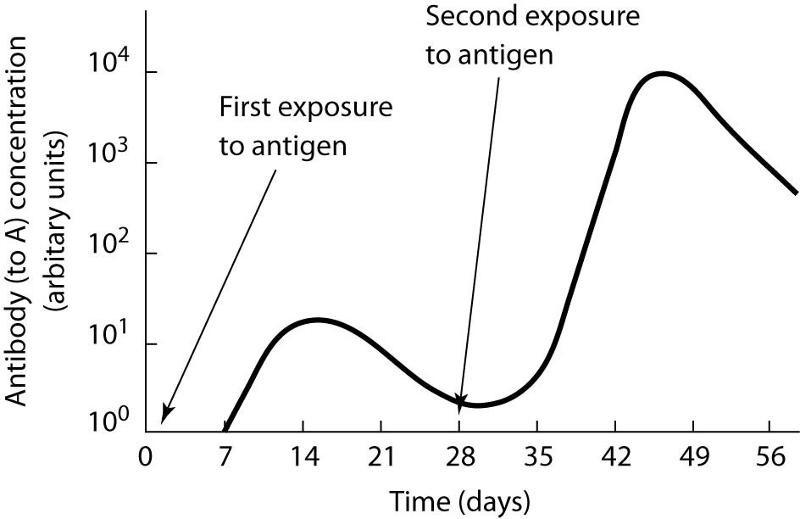
*82) According to the graph, naive B cells will produce effector cells
A) between 0 and 7 days.
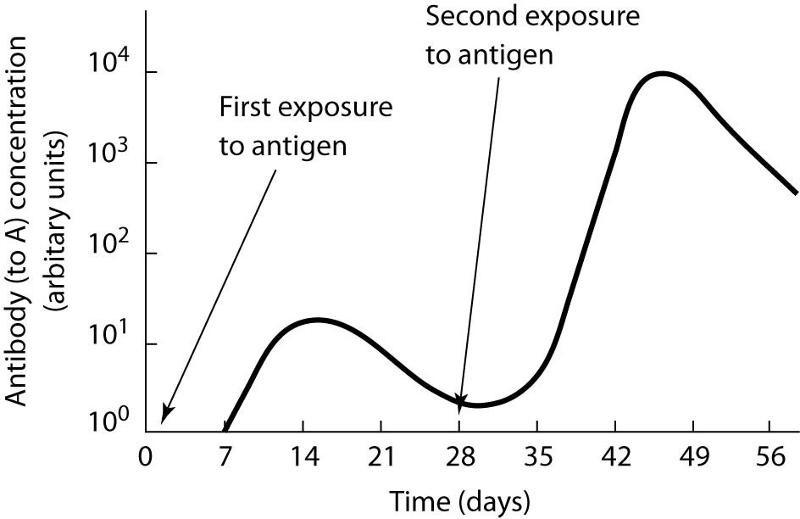
*83) According to the graph, naive memory cells will be produced
E) both between 0 and 7 days and between 28 and 35 days.
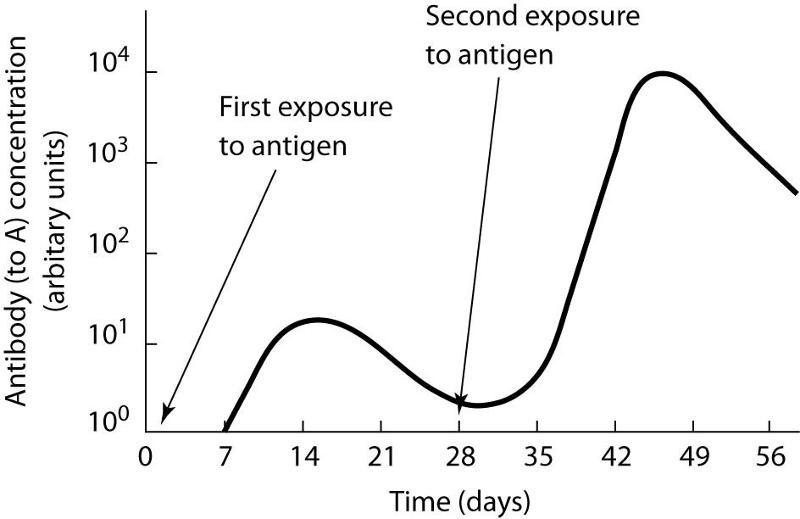
*84) According to the graph, antibodies will be produced
E) both between 3 and 7 days and between 28 and 35 days.

*85) Study the table. The mother could exhibit an anti-Rh-factor reaction to the developing fetus in
A) Case 1 only.

*86) In Cases 1 and 2 in the table, the mothers would be able, if needed, to supply blood to the newborn even seven to nine months after birth; the same would not be true for Case 3. This is because
B) the newborn in Case 3 would soon be able to make antibodies to the B antigen of the mother.

*87) Study the table. Giving the mother anti-Rh antibodies before delivering her baby would be a wise precaution in
A) Case 1 only.
*88) After a long and cold winter, Jim was excited to start exploring the woods behind his new home. His first adventure included exposure to poison ivy without any reaction. A month later, though, a second walk through the woods was not so great, since two days later Jim had a terrible rash that lasted for weeks. The fact that the rash took two days to develop indicates that this immune response was an example of
B) cell-mediated immunity.
*89) Her immune system's recognition of the second infection involves the
D) cytotoxic T cells.
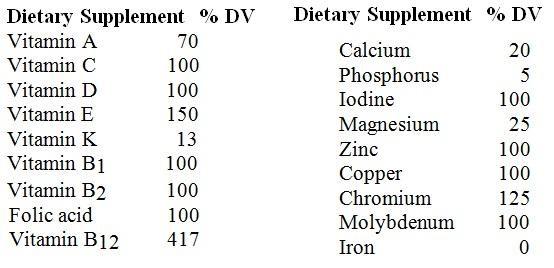
*9) The most likely reason that some of the vitamins and minerals in this supplement are found at less than 100% is
D) it is dangerous to overdose on fat-soluble vitamins such as A and K.
*90) The EBV antigen fragments will be presented by the virus-infected cells along with
C) class I MHC molecules.
*91) Select the description that likely indicates a child with Bruton's disease.
C) baby boy Jeff, with no plasma cells following infection by bacterial pneumonia
*92) Bruton's disorder will likely include
A) the failure of heavy-chain gene rearrangement in B cells.
*93) Assume that a DGS-like phenotype was produced in a specific "gene-knockout" mouse, one lacking expression of HA3, a Hox gene known to be involved in developmental regulation in the mouse.
The phenotype of the HA3 knockout can be ascertained by
1) Gas exchange in the aquatic salamander known as the axolotl is correctly described as
D) simple diffusion of oxygen into the salamander from the water.
1) In a well-fed human eating a Western diet, the richest source of stored chemical energy in the body is
A) fat in adipose tissue.
1) Innate immunity
A) is activated immediately upon infection.
1) When the temperature of the outside air exceeds their internal body temperature, jackrabbits living in hot, arid lands will
B) constrict the blood vessels in their large ears to reduce transfer of external heat to the blood in their ears.
10) The complement system is
D) a group of antimicrobial proteins that act together in a cascade fashion.
10) The only vertebrates in which blood flows directly from respiratory organs to body tissues without first returning to the heart are the
C) fishes.
10) To increase the effectiveness of exchange surfaces lining the lungs and the intestines, evolutionary pressures have
A) increased the exchange surface area with folds and branches.
100) Which of the following would not help a virus avoid triggering an adaptive immune response?
C) producing proteins very similar to those of other viruses
11) Antihistamine treatment reduces
A) blood vessel dilation.
11) The specialized function shared by the cells that line the lungs and those that line the lumen of the gut is that both types of cells
B) provide abundant exchange surface.
11) To adjust blood pressure independently in the capillaries of the gas-exchange surface and in the capillaries of the general body circulation, an organism would need a(n)
E) four-chambered heart.
12) A portal system is
E) a vessel or vessels connecting two capillary beds.
12) Cave art by early humans recognized the existence of the major signs of inflammation. The most inclusive set of symptoms of inflammation that might appear in such early human art is
E) swelling, heat, redness, and pain.
12) Interstitial fluid is
D) the route for the exchange of materials between blood and body cells.
13) Ancient peoples sought to identify the indicators of inflammation because
D) the presence of these signs suggests that healing was taking place; otherwise, the patient would likely die.
13) Multicellular organisms must keep their cells awash in an "internal pond" because
B) an aqueous medium is needed for the cellular exchange of nutrients, gases, and wastes.
13) Which of the following develops the greatest pressure on the blood in the mammalian aorta?
C) systole of the left ventricle
14) The cells and signaling molecules that initiate inflammatory responses are
D) the mast cells and the histamines.
14) Tissues are composed of cells, and tissues functioning together make up
A) organs.
14) Which of the following pairs of mammalian blood vessels has blood that is the least similar in its gas content?
A) the pulmonary vein and the jugular vein
15) After several weeks of exercise, a human athlete's resting heart rate is typically lower than before because
C) the stroke volume has increased.
15) An exchange surface in direct contact with the external environment is found in the
A) lungs.
15) In marine sponges, intracellular digestion of peptides is usually immediately preceded by
B) endocytosis.
15) Inflammatory responses typically include
B) increased activity of phagocytes in an inflamed area.
16) A human red blood cell in an artery of the left arm is on its way to deliver oxygen to a cell in the thumb. To travel from the artery in the arm to the left ventricle, this red blood cell must pass through
B) two capillary beds.
16) Bacteria entering the body through a small cut in the skin
E) activate a group of proteins called complement.
16) Of the following choices, the epithelium with the shortest diffusion distance is
A) simple squamous epithelium.
16) The large surface area in the gut directly facilitates
B) absorption.
17) An advantage of a complete digestive system over a gastrovascular cavity is that the complete system
B) allows specialized functions in specialized regions.
17) An invertebrate, such as an insect, has innate immunity activity in its intestine that likely includes
B) lysozyme.
17) The absorptive epithelia in the gut are considered "polarized" because
E) the structures on the apical surface are different than those on the basal surface.
17) Which of the following is the correct sequence of blood flow in reptiles and mammals?
D) vena cava → right atrium → right ventricle → pulmonary circuit
18) A patient with a blood pressure of 120/75, a pulse rate of 40 beats/minute, a stroke volume of 70 mL/beat, and a respiratory rate of 25 breaths/minute will have a cardiac output of
D) 2,800 mL/minute.
18) Earthworms, grasshoppers, and birds all have a
C) crop.
18) In some insects, such as Drosophila, fungal cell wall elements can activate the protein Toll, which
A) acts as a receptor that, when activated, signals synthesis of antimicrobial peptides.
18) Most of the exchange surfaces of multicellular animals are lined with
D) epithelial tissue.
19) An example of a connective tissue is the
C) blood.
19) Because the foods eaten by animals are often composed largely of macromolecules, this requires the animals to have mechanisms for
C) enzymatic hydrolysis.
19) Damage to the sinoatrial node in humans
D) would disrupt the rate and timing of cardiac muscle contractions.
19) Mammals have Toll-like receptors (TLRs) that can recognize a kind of macromolecule that is absent from vertebrates but present in/on certain groups of pathogens, including viral
C) double-stranded RNA.
2) Acidity in human urine is an example of
E) innate immunity.
2) Animals that migrate great distances would obtain the greatest energetic benefit of storing chemical energy as
E) fats.
2) Circulatory systems have the primary benefit of overcoming the shortcomings of
B) the slow rate at which diffusion occurs across cells.
2) If thermoregulation is considered to be a secondary function of the large ears of jackrabbits, then the primary function of the ears is
C) to detect predators by using the large size and flexible positioning of the external ears to channel sound waves into the ear canal.
20) A stroke volume in the heart of 70 mL/cycle, with a pulse of 72 cycles per minute, results in a cardiac output of
A) 5 L/minute.
20) Histamines trigger dilation of nearby blood vessels as well as an increase in their permeability, producing
D) redness, heat, and swelling.
20) In the digestive system, peristalsis is
E) smooth muscle contractions that move food along the esophagus.
20) Stratified cuboidal epithelium is composed of
A) several layers of boxlike cells.
21) After ingestion by humans, the first category of macromolecules to be chemically digested by enzymes in the mouth is
B) carbohydrates.
21) Coordinating body functions via chemical signals is accomplished by
B) the endocrine system.
21) Septic shock, a systemic response including high fever and low blood pressure, is a response to
A) certain bacterial infections.
21) The semilunar valves of the mammalian heart
D) prevent backflow of blood in the aorta and pulmonary arteries.
22) Connective tissues typically have
D) relatively few cells and a large amount of extracellular matrix.
22) Infection by a bacterium that has elements on its surface that enhance its resistance to lysozyme will likely result in
B) successful reproduction of the bacterium and continued progression of the disease.
22) Salivary amylase digests
B) starches.
22) The material present in arterioles that is not present in capillaries is
D) circular smooth muscle cells that can alter the size of the arterioles.
23) Adaptive immunity depends on
B) pathogen-specific recognition.
23) Among mammals, it is generally true that
C) the epiglottis prevents swallowed food from entering the trachea.
23) The fibers responsible for the elastic resistance properties of tendons are
C) collagenous fibers.
23) The set of blood vessels with the slowest velocity of blood flow is
D) the capillaries.
24) Bacterial infection in a previously uninfected house cat would most quickly activate its
A) Toll-like receptors that bind to lipopolysaccharides.
24) Digestive secretions with a pH of 2 are characteristic of the
B) stomach.
24) If you gently twist your earlobe, it does not remain distorted because it contains
B) elastin fibers.
24) The set of blood vessels with the lowest blood pressure driving flow is
E) the veins.
25) A key part of the humoral immune response is
B) the production of antibodies by plasma cells.
25) An increased concentration of nitric oxide within a vascular bed is associated with
B) vasodilation.
<p>25) Pepsin is a digestive enzyme that</p> D) begins the hydrolysis of proteins in the stomach.
D) begins the hydrolysis of proteins in the stomach.
25) The nourishment, insulation, and support for neurons is the result of activity by the
E) glial cells.
26) Among the following choices, which organism likely has the highest systolic pressure?
E) giraffe
26) Fibroblasts secrete
E) proteins for connective fibers.
26) The receptors on T cells and B cells bind to
B) antigens.
26) Upon activation by stomach acidity, the secretions of the parietal cells
A) initiate the digestion of protein in the stomach.
27) An epitope is
D) that part of an antigen that actually binds to an antigen receptor.
27) Breathing is accomplished via the rhythmic contraction and relaxation of
B) skeletal muscle.
27) Small swollen areas in the neck, groin, and axillary region are associated with
A) increased activity of the immune system.
27) The bile salts
C) emulsify fats in the duodenum.
28) B cells have antigen receptors that bind to antigens that are either freely dissolved or present on the surface of invading/foreign cells. T cells have antigen receptors that
D) bind to antigens presented on major histocompatability complexes by host cells.
28) Blood is best classified as connective tissue because
A) its cells are separated from each other by an extracellular matrix.
28) Complex nutrients are digested and then absorbed into the lymph or bloodstream as
C) monomers.
28) The velocity of blood flow is the lowest in capillaries because
E) the total cross-sectional area of the capillaries is greater than the total cross-sectional area of the arteries or any other part of the circulatory system.
29) An enzyme with high activity in an acidic environment is
B) pepsin.
29) Muscles are joined to bones by
B) tendons.
<p>29) The blood pressure is lowest in the</p> E) venae cavae.
E) venae cavae.
29) Within a differentiated B cell, the rearrangement of DNA sequences between variable regions and joining regions is accomplished by
E) recombinase.
3) A fruit fly, internally infected by a potentially pathogenic fungus, is protected by
D) its antimicrobial peptides.
3) Certain nutrients are considered "essential" in the diets of some animals because
C) these animals are not able to synthesize these nutrients.
3) To become bound to hemoglobin for transport in a mammal, atmospheric molecules of oxygen must cross
E) five membranes - in and out of the cell lining the lung, in and out of the endothelial cell lining the pulmonary capillary, and into the red blood cell - to bind with hemoglobin.
3) Which choice best describes a reasonable mechanism for animal structures becoming better suited over evolutionary time to specific functions?
C) Animals with mutations that give rise to effective structures will become more abundant.
<p>30) Clonal selection of B cells activated by antigen exposure leads to production of</p> E) short-lived plasma cells that secrete antibodies for the antigen.
E) short-lived plasma cells that secrete antibodies for the antigen.
30) Fluid is filtered out of the bloodstream into the surrounding interstitial fluid at the arteriole end of systemic capillaries because
C) the hydrostatic pressure of the blood is greater than the osmotic pressure of the blood.
30) Most types of communication between cells utilize
C) the release of chemical signals by the cell sending the message.
30) The absorption of fats differs from that of carbohydrates in that the
D) most absorbed fat first enters the lymphatic system, whereas carbohydrates directly enter the blood.
31) A nutritional monomer that can be transported in the blood after a typical meal is
C) fatty acid.
31) Antigens are
D) foreign molecules that trigger the generation of antibodies.
31) If, during protein starvation, the osmotic pressure on the venous side of capillary beds drops below the hydrostatic pressure, then
B) fluids will tend to accumulate in tissues.
31) With its abundance of collagenous fibers, cartilage is an example of
A) connective tissue.
32) A matrix of connective tissue is apparent in
A) chondroitin sulfate of cartilage.
32) A newborn who is accidentally given a drug that destroys the thymus would most likely
D) be unable to differentiate and mature T cells.
32) For a nondiabetic person, the glucose concentration in this part of the vasculature varies more than in any other part.
D) hepatic portal vessel
32) What will be the long-term effect of blocking the lymphatic vessels associated with a capillary bed?
C) the accumulation of more fluid in the interstitial areas
33) A species that has a normal resting systolic blood pressure of >260 mm Hg is likely to be
D) an animal that has a very long distance between its heart and its brain.
33) Clonal selection implies that
B) antigens increase mitosis in specific lymphocytes.
33) Glandular secretions that are released initially as inactive precursors of digestive enzymes are the
A) protein-digesting enzymes.
33) In a typical nerve cell, the nucleus is found in the
A) cell body.
34) All types of muscle tissue have
E) interactions between actin and myosin.
34) Because adult lampreys attach onto the surface of large fish for long periods of time to feed on body fluids, they can accomplish nutritional balance without need for a
D) stomach.
34) Clonal selection is an explanation for how
C) an antigen can provoke production of high levels of specific antibodies.
34) Dialysis patients, who will have blood withdrawn, dialyzed, then replaced, are always weighed when they enter the facility and then weighed carefully again before they leave, because
A) even small changes in body weight may signify changes in blood volume and therefore
35) All skeletal muscle fibers are both
C) striated and under voluntary control.
35) Constipation can result from the consumption of a substance that
B) promotes water reabsorption in the large intestine.
35) Large proteins such as albumin remain in capillaries rather than diffusing out, resulting in the
B) development of an osmotic pressure difference across capillary walls.
35) Secondary immune responses upon a second exposure to a pathogen are due to the activation of
A) memory cells.
36) Cardiac muscle cells are both
A) striated and interconnected by intercalated disks.
36) Historically inaccurate diagnosis of acid reflux disorders and gastric ulcers has been improved by
C) the diagnosis and treatment of H. pylori infection.
36) The MHC is important in a T cell's ability to
A) distinguish self from nonself.
36) Vasoconstriction in the gut is a likely response when an individual is
C) stressed and secreting stress hormones.
37) A hiatal hernia that disrupts the functional relationship between the smooth muscle in the esophagus and that in the stomach would be most likely to increase the frequency of
A) gastric reflux.
37) A patient who can produce antibodies against some bacterial pathogens, but not against viral infections, probably has a disorder in his
D) T cells.
37) The diagnosis of hypertension in adults is based on the
D) blood pressure being greater than 140 mm Hg systolic and/or >90 diastolic.
37) The type of muscle tissue surrounding internal organs, other than the heart, is
E) smooth muscle.
38) A significant contribution of intestinal bacteria to human nutrition is the benefit of bacterial
D) production of vitamin K.
38) Among these choices, the biggest set that includes only those "cells" that lack nuclei is
B) platelets and erythrocytes.
38) Food moves along the digestive tract as the result of contractions by
B) smooth muscle.
38) The activation of helper T cells is likely
A) when an antigen is displayed by a dendritic cell.
39) An immunoglobulin (Ig) molecule, of whatever class, with regions symbolized as C or V, H or L, has a light chain made up of
A) one C region and one V region.
39) In a healthy human, the typical life span of a red blood cell is
D) four months.
39) The cells lining the air sacs in the lungs make up a
B) simple squamous epithelium.
39) The cells that secrete acidic fluid in the stomach are
D) in the lumen of the stomach.
4) Engulfing-phagocytic cells of innate immunity include all of the following except
D) natural killer cells.
4) Penguins, seals, and tuna have body forms that permit rapid swimming, because
D) the shape is a convergent evolutionary solution to the need to reduce drag while swimming.
4) The fluid that moves around in the circulatory system of a typical arthropod is
E) the interstitial fluid.
4) To maintain adequate nutrition, animals require dietary access to certain amino acids. An amino acid that is referred to as "nonessential" would be best described as one that
A) can be made by the animal's body from other substances.
40) Stomach cells are moderately well adapted to the acidity and protein-digesting activities in the stomach by having
B) a thick, mucous secretion and active mitosis of epithelial cells.
40) The ability of one person to produce over a million different antibody molecules does not require over a million different genes; rather, this wide range of antibody production is due to
C) DNA rearrangements.
40) The body's automatic tendency to maintain a constant and optimal internal environment is termed
C) homeostasis.
40) The hormone that stimulates the production of red blood cells, and the organ where this hormone is synthesized, are
B) erythropoietin and kidney, respectively.
41) An example of a properly functioning homeostatic control system is seen when
B) the kidneys excrete salt into the urine when dietary salt levels rise.
41) Dissolved proteins in human plasma include which of the following?
I. fibrinogen and III.immunoglobulin only
41) Immunological memory accounts for
D) the ancient observation that someone who had recovered from the plague could safely care for those newly diseased.
41) The molar teeth of herbivorous mammals are especially effective at
C) grinding.
42) A group of animals among which a relatively long cecum is likely to be found is the
B) herbivores.
42) An example of effectors' roles in homeostatic responses is observable when
A) an increase in body temperature results from involuntary shivering.
42) The function of antibodies is to
E) mark pathogenic cells for destruction.
42) The plasma proteins in humans
A) maintain the blood's osmotic pressure.
43) Cyanide poisons mitochondria by blocking the final step in the electron transport chain. Human red blood cells placed in an isotonic solution containing cyanide are likely to
E) be unaffected.
43) Positive feedback has occurred when
C) uterine contractions needed for the birthing process are expedited by the pressure of a moving baby in its mother's uterus.
43) The adaptations suited to a carnivorous diet include
D) bile salts.
43) This type of immunity is present only when a newborn infant is being fed by actively nursing on its mother and ends when nursing ends.
C) passive immunity
44) Cattle are able to survive on a diet consisting almost entirely of plant material because
E) they have cellulose-digesting, symbiotic microorganisms in chambers of their stomachs.
44) Heart rate will increase in the presence of increased
D) epinephrine.
44) Positive feedback differs from negative feedback in that
<p>B) the positive feedback's effector responses are in the same direction as the initiating stimulus rather than opposite to it.</p> 44) Yearly vaccination of humans for influenza viruses is necessary because
44) Yearly vaccination of humans for influenza viruses is necessary because
D) rapid mutation in flu viruses alters the surface proteins in infected host cells.
45) Analysis of jawbones from the skeletal remains of a vertebrate animal reveal its dietary patterns owing to
B) the prevalence of specific kinds of teeth.
45) The cell-mediated immunity that destroys virally infected cells involves
A) cytotoxic T cells.
45) The production of red blood cells is stimulated by
C) erythropoietin.
45) To prepare flight muscles for use on a cool morning, hawkmouth moths
C) rapidly contract and relax these muscles to generate metabolic warmth.
46) An enlarged cecum is typical of
A) rabbits, horses, and herbivorous bears.
46) In a survivably cold environment, an ectotherm is more likely to survive an extended period of food deprivation than would an equally sized endotherm because the ectotherm
C) invests little energy in temperature regulation.
46) The meshwork that forms the fabric of a blood clot is
B) fibrin.
46) Which of the following cells are involved in cell-mediated immunity and also respond to class I MHC molecule-antigen complexes?
<p>A) cytotoxic T cells</p> 47) A normal event in the process of blood clotting is the
47) A normal event in the process of blood clotting is the
C) activation of prothrombin to thrombin.
47) Coprophagy, the nutrition-boosting ingestion of fecal material, is important for the nutritional balance of
C) rabbits and their relatives.
47) Humans can lose, but cannot gain, heat through the process of
D) evaporation.
47) The cells involved in innate immunity, whose absence increases the chances of developing malignant tumors, are
B) natural killer cells.
48) An example of an ectothermic organism that has few or no behavioral options when it comes to its ability to adjust its body temperature is a
B) sea star, a marine invertebrate.
48) PKU (phenylketonuria) is a hereditary condition in which infants and young children who ingest the amino acid phenylalanine risk serious neurological damage. However, the risk of damage can be substantially reduced by the severe restriction of phenylalanine in the diet. Which of the following is the nutritional concept that forms the basis for this preventive treatment?
B) essential nutrients
48) Select the pathway that would lead to the activation of cytotoxic T cells.
B) body cell becomes infected with a virus → new viral proteins appear → class I MHC molecule-antigen complex displayed on cell surface
48) When the air in a testing chamber is specially mixed so that its oxygen content is 10% and its overall air pressure is 400 mm Hg, then PO₂ is
C) 40 mm Hg.
49) Among the last line of defenses against prolonged exposure to an extracellular pathogen is
C) antibody production by plasma cells.
49) An overheated and sick dog in a hot environment will have an impaired thermoregulatory response when its
C) body temperature increases to match the environmental temperature.
49) The sun shining on a tidal pool during a hot day heats the water. As some water evaporates, the pool becomes saltier, causing
B) a decrease in its oxygen content.
49) When the digestion and absorption of organic molecules results in more energy-rich molecules than are immediately required by an animal, the excess is
C) stored as glycogen in the liver and muscles.
5) Circulatory systems in molluscs
D) are open in species of small-sized molluscs and are closed in species of large-sized molluscs.
5) Evolutionary adaptations that help diverse animals directly exchange matter between cells and the environment include
B) an external respiratory surface, a small body size, and a two-cell-layered body.
5) The lymphatic fluid
A) is a filtrate of the blood, as is urine.
5) Which pair correctly associates a physiological process with the appropriate vitamin?
B) normal vision and vitamin A
50) Arrange these components of the mammalian immune system as it first responds to a pathogen in the correct sequence.
III. Antigenic determinants from pathogen bind to antigen receptors on lymphocytes. --> IV. Lymphocytes specific to antigenic determinants from pathogen become numerous. --> II. Lymphocytes secrete antibodies. --> I. Pathogen is destroyed. --> V. Only memory cells remain.
50) Endothermy
B) is a characteristic of animals that have a fairly constant body temperature.
50) Hypoglycemia, or low levels of glucose in the blood of a healthy human, is "corrected" by a(n)
B) increase in the secretion of glucagon.
50) Sponges, cnidarians, and flatworms lack a specialized gas exchange surface because
E) nearly all of their cells are in direct contact with the external environment.
51) A cell type that interacts with both the humoral and cell-mediated immune pathways is a
E) helper T cell.
51) A fasting animal whose energy needs exceed those provided in its diet draws on its stored resources in which order?
C) liver glycogen, then muscle glycogen, then fat
51) Flying insects do all of the following except
B) switch from diffusion of tracheal gases to active transport during flight.
51) The panting responses that are observed in overheated birds and mammals dissipates excess heat by
E) evaporation.
52) A nonfunctional CD4 protein on a helper T cell would result in the helper T cell being unable to
E) interact with a class II MHC-antigen complex.
52) An example of an organism that has only behavioral controls over its body temperature is the
A) green frog.
52) Obesity in humans is most clearly linked to
D) type 2 diabetes and cardiovascular disease.
52) The epiglottis of a human covers the glottis when he or she is
C) swallowing.
53) CD4 and CD8 are
D) molecules present on the surface of T cells where they interact with MHC molecules.
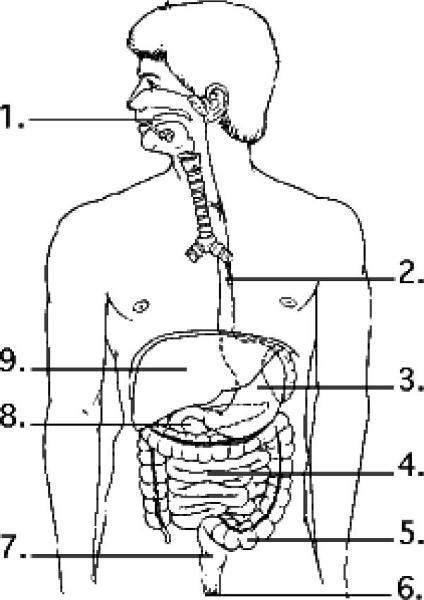
53) Examine the digestive system structures in the figure above. The agents that help emulsify fats are produced in
E) 9
53) In mammals, most gas exchange between the atmosphere and the pulmonary blood occurs in the
E) alveoli.
53) Most land-dwelling invertebrates and all of the amphibians
<p>A) are ectothermic organisms with variable body temperatures.</p> 54) Examine the digestive system structures in the figure above. The highest rate of nutrient absorption occurs at location(s)
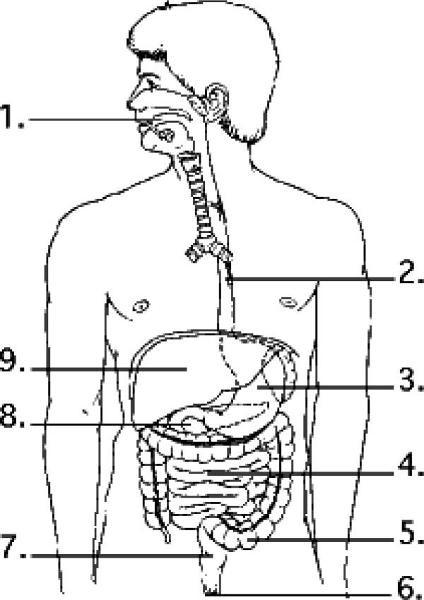
54) Examine the digestive system structures in the figure above. The highest rate of nutrient absorption occurs at location(s)
B) 4 only.
54) Gas exchange is more difficult for aquatic animals with gills than for terrestrial animals with lungs because
<p>B) water contains much less O₂ than air per unit volume.</p> 54) T cells of the immune system include
54) T cells of the immune system include
B) cytotoxic and helper cells.
54) The temperature-regulating center of vertebrate animals is located in the
C) hypothalamus.
55) A female Burmese python incubating her eggs can warm them using
E) shivering thermogenesis.
55) B cells interacting with helper T cells are stimulated to differentiate when
E) helper T cells release cytokines.
55) Countercurrent exchange is evident in
A) the flow of water across the gills of a fish and that of blood within those gills.
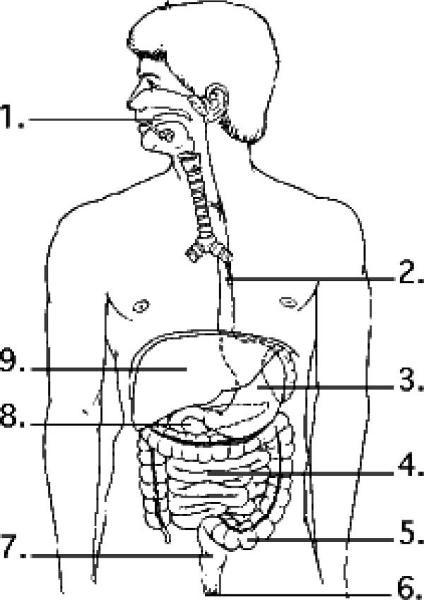
55) Examine the digestive system structures in the figure above. Most of the digestion of fats occurs in section(s)
B) 4 only.
56) Countercurrent exchange in the fish gill helps to maximize
C) diffusion.
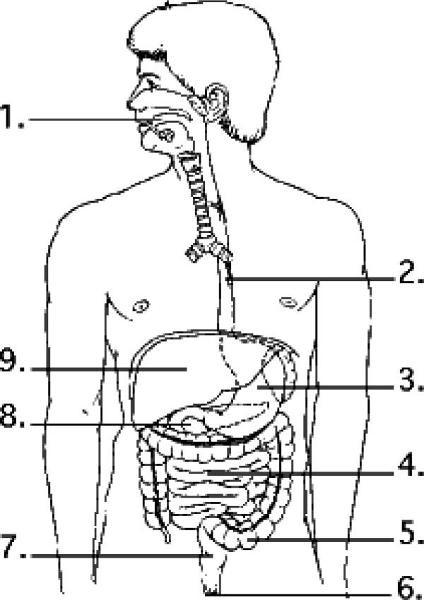
56) Examine the digestive system structures in the figure above. Bacteria that produce vitamins as products are residents of location
C) 5.
56) In mammals this response is known as fever, but it is known to raise body temperature in other bacterially infected animals, including lizards, fishes, and cockroaches.
D) a change in the body's thermostat "set point"
56) Normal immune responses can be described as polyclonal because
D) diverse antibodies are produced for different epitopes of a specific antigen.
57) Air-breathing insects carry out gas exchange
D) across the membranes of their cells.
57) Antibodies of the different classes IgM, IgG, IgA, IgD, and IgE differ from each other
B) in their heavy-chain structure.
57) Ingested foods inside the digestive tract of snakes are typically digested by
B) enzymatic hydrolysis.
57) Leptin is a product of adipose cells. Therefore, a very obese mouse would be expected to have
D) mutation of ob or db.
58) An oil-water mixture works as an insecticidal spray against mosquitoes and other insects because it
B) blocks the openings into the tracheal system.
58) Many obese humans produce normal or increased levels of leptin without satiety, so the search for healthy regulation of food intake should focus on
D) eliminating carbohydrates from the diet.
58) Seasonal changes in snake activity are due to the fact that the snake
D) is more active in summer because it can gain body heat by conduction.
58) When antibodies bind antigens, the clumping of antigens results from
A) the multivalence of the antibody having at least two binding regions.
59) Atmospheric pressure at sea level is equal to a column of 760 mm Hg. Oxygen makes up 21% of the atmosphere by volume. The partial pressure of oxygen (PO₂) in such conditions is
A) 160 mm Hg.
59) Phagocytosis of microbes by macrophages is enhanced byD) the binding of antibodies to the surface of microbes and antibody-mediated agglutination of microbes only.
D) the binding of antibodies to the surface of microbes and antibody-mediated agglutination of microbes only.
59) Standard metabolic rate (SMR) and basal metabolic rate (BMR) are
E) both measured in animals in a resting and fasting state.
59) Which of the following animals is incorrectly paired with its feeding mechanism?
A) lion --> substrate feeder
6) An inflammation-causing signal released by mast cells at the site of an infection is
C) histamine.
6) The circulatory system of bony fishes, rays, and sharks is similar to
B) the portal systems of mammals, where two capillary beds occur sequentially, without passage of blood through a pumping chamber.
6) The fat-soluble vitamins include
A) vitamin A.
6) The similar fusiform body shape of diverse animals, such as sharks, penguins, and aquatic mammals, has evolved because
C) this is the body shape that makes it possible for aquatic animals to swim rapidly.
60) For adult human females, the metabolic "costs" of pregnancy and lactation are
C) 5-8% more than when she was nonpregnant.
60) Some human infants, especially those born prematurely, suffer serious respiratory failure because of
D) lung collapse due to inadequate production of surfactant.
60) The mammalian trachea and esophagus both connect to the
C) pharynx.
60) The primary function of humoral immunity is
D) to protect the body against extracellular pathogens.
61) Among these choices, the least reliable indicator of an animal's metabolic rate is the amount of
E) water consumed in one day.
61) Naturally acquired passive immunity results from the
C) placental transfer of antibodies.
61) Of the following choices, impairment of a mammal's breathing cycle is most likely following neural damage in
B) the medulla oblongata and the pons.
61) Which of the following organs is incorrectly paired with its function?
C) large intestine --> bile production
62) Air rushes into the lungs of humans during inhalation because
A) the rib muscles and diaphragm contract, increasing the lung volume.
62) During its months-long hibernation in its burrow, the body temperature of a ground squirrel
C) varies between 5°C and 37°C, depending on the frequency of arousals from hibernation.
62) In active immunity, but not passive immunity, there is
D) the requirement for direct exposure to a living or simulated pathogen.
62) Which of the following is not a major activity of the stomach?
D) nutrient absorption
63) "Winter acclimatization" in cold-zone mammals can include
C) hibernation for several weeks.
63) After surgical removal of an infected gallbladder, a person must be especially careful to restrict dietary intake of
D) fat.
63) Jenner's successful use of cowpox virus as a vaccine against the smallpox virus is due to the fact that
D) there are some antigenic determinants common to both pox viruses.
63) The exhalation of air from human lungs is driven by
A) a decrease in the volume of the thoracic cavity.
64) An individual who has been bitten by a poisonous snake that has a fast-acting toxin would likely benefit from
B) injection of antibodies to the toxin.
64) As a person goes from rest to full-effort exercise, there is an increase in the
A) tidal volume.
64) Hibernation and estivation during seasons of environmental stress are both examples of
B) torpor.
64) If you were to jog 1 km a few hours after lunch, which stored fuel would you probably tap?
B) muscle and liver glycogen
65) A person with a tidal volume of 450 mL, a vital capacity of 4,000 mL, and a residual volume of 1,000 mL would have a potential total lung capacity of
D) 5,000 mL.
65) For the successful development of a vaccine to be used against a pathogen, it is necessary that
A) the surface antigens of the pathogen not change.
65) Panting by an overheated dog achieves cooling by
C) evaporation.
66) A diseased patient is exposed to an unknown agent while out of the country. The patient's blood is found to have a high proportion of lymphocytes with CD8 surface proteins in her blood, a likely result of
D) a viral infection eliciting proliferation of CD8+ cytotoxic T cells.
66) Catabolism of specialized brown fat depots in certain animals is substantially increased during
D) nonshivering thermogenesis.
66) During most daily activities, the human respiration rate is most closely linked to the blood levels of
D) carbon dioxide.
67) A moth preparing for flight on a cold morning warms its flight muscles via
E) shivering thermogenesis.
67) Breathing is usually regulated by
D) CO₂ and O₂ concentration and pH-level sensors.
67) The switch of one B cell from producing one class of antibody to another antibody class that is responsive to the same antigen is due to
E) the rearrangement of immunoglobulin heavy-chain C region DNA.
68) At an atmospheric pressure of 870 mm Hg of 21% oxygen, the partial pressure of oxygen is
D) 182 mm Hg.
68) The number of MHC protein combinations possible in a given population is enormous. However, an individual in that diverse population has a far more limited array of MHC molecules because
C) each of the MHC genes has a large number of alleles, but each individual only inherits two for each gene.
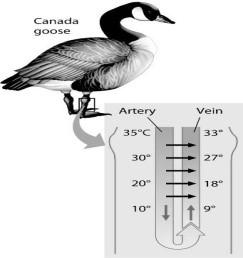
68) The thin horizontal arrows in the figure above show that
C) the warmer arterial blood transfers heat to the cooler venous blood.
69) A bone marrow transplant may not be appropriate from a given donor (Jane) to a given recipient (Jane's cousin Bob), even though Jane has previously given blood for one of Bob's needed transfusions, because
A) even though Jane's blood type is a match to Bob's, her MHC proteins may not be a match.
69) At sea level, atmospheric pressure is 760 mm Hg. Oxygen gas is approximately 21% of the total gases in the atmosphere, so the approximate partial pressure of oxygen is
D) 160.0 mm Hg.
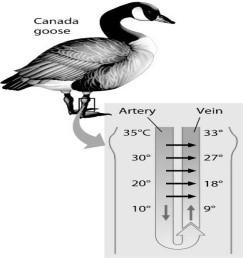
69) Examine the figure above. Near a goose's abdomen, the countercurrent arrangement of the arterial and venous blood vessels causes
A) the temperature difference between the contents of the two sets of vessels to be minimized.
7) A significant increase in the amount of interstitial fluid surrounding the capillary beds of a human's lungs will cause
C) a decrease in the amount of oxygen moving from the lungs into the blood.
7) A systemic inflammatory response that is often life-threatening is
C) septic shock.
7) The specialized structures of complex animals have evolved because
D) they permit adjustments to a wide range of environmental changes.
7) Which pair correctly associates a biochemical process with the appropriate mineral associated with its use in animals?
A) maintenance of bone and calcium
70) At the summit of a high mountain, the atmospheric pressure is 380 mm Hg. If the atmosphere is still composed of 21% oxygen, then the partial pressure of oxygen at this altitude is
<p>B) 80 mm Hg.</p> 70) Imagine that you are a biologist who is attempting to get an accurate measure of an animal's basal metabolic rate. The best time to measure the metabolic rate is when the animal
70) Imagine that you are a biologist who is attempting to get an accurate measure of an animal's basal metabolic rate. The best time to measure the metabolic rate is when the animal
A) is resting and has not eaten its first meal of the day.
70) Infection with HIV typically
A) increases the level of helper T cells for the first year after infection.
71) Carbon dioxide levels in the blood and cerebrospinal fluid affect its pH. This enables the organism to sense a disturbance in gas levels as
B) the medulla oblongata, which is in contact with cerebrospinal fluid, monitors pH and uses this measure to control breathing.
71) The body tissue that consists largely of material located outside of cells is
B) connective tissue.
71) The transfusion of type A blood to a person who has type O blood would result in
B) the recipient's anti-A antibodies clumping the donated red blood cells.
72) An immune response to a tissue graft will differ from an immune response to a bacterium because
A) MHC molecules of the donor may stimulate rejection of the graft tissue, but bacteria lack MHC molecules.
72) An increase from pH 7.2 to pH 7.4 around hemoglobin causes
B) an increase in the affinity of hemoglobin to bind oxygen molecules.
72) Which of the following would increase the rate of heat exchange between an animal and its environment?
C) wind blowing across the body surface
73) An "internal reservoir" of oxygen in rested muscle is found in oxygen molecules bound to
E) myoglobin.
73) Consider the energy budgets for a human, an elephant, a penguin, a mouse, and a snake. The ________ would have the highest total annual energy expenditure, and the ________ would have the highest energy expenditure per unit mass.
<p>A) elephant; mouse</p> 73) In the human disease known as lupus, there is an immune reaction against a patient's own DNA from broken or dying cells, which categorizes lupus as
73) In the human disease known as lupus, there is an immune reaction against a patient's own DNA from broken or dying cells, which categorizes lupus as
C) an autoimmune disease.
74) A patient who undergoes a high level of mast cell degranulation, dilation of blood vessels, and acute drop in blood pressure is likely suffering from
E) anaphylactic shock immediately following exposure to an allergen.
74) Compared with a smaller cell, a larger cell of the same shape has
B) less surface area per unit of volume.
74) Hemoglobin and hemocyanin
D) both transport oxygen.
75) An animal's inputs of energy and materials would exceed its outputs
D) if it is growing and increasing its mass.
75) An example of a pathogen that undergoes rapid changes resulting in antigenic variation is
A) the influenza virus, which expresses alternative envelope proteins.
75) The Bohr shift on the oxygen-hemoglobin dissociation curve is produced by changes in
E) pH.
76) Most of the carbon dioxide produced by humans is
A) converted to bicarbonate ions by an enzyme in red blood cells.
76) The ability of some viruses to remain inactive (latent) for a period of time is exemplified by
B) herpes simplex viruses (oral or genital) whose reproduction is triggered by physiological or emotional stress in the host.
76) You are studying a large tropical reptile that has a high and relatively stable body temperature. How would you determine whether this animal is an endotherm or an ectotherm?
C) You subject this reptile to various temperatures in the lab and find that its body temperature and metabolic rate change with the ambient temperature. You conclude that it is an ectotherm.
77) Hydrogen ions produced within human red blood cells are prevented from significantly lowering plasma pH because they bind to
A) hemoglobin.
77) Most newly emerging diseases result in
C) the waning of the disease, due to evolutionary selection for resistant hosts and milder pathogens.
77) Which of the following animals uses the largest percentage of its energy budget for homeostatic regulation?
E) a desert bird
78) Preventing the appearance of the symptoms of an allergy attack would be the likely result of
A) blocking the attachment of the IgE antibodies to the mast cells.
78) The hemocyanin of arthropods and molluscs differ from the hemoglobin of mammals in that
C) hemocyanin has protein coupled to copper rather than iron.
79) A patient complaining of watery, itchy eyes and sneezing after being given a flower bouquet as a birthday gift should first be treated with
<p>D) antihistamines.</p> 79) In an animal species known for endurance running rather than fast sprinting, you would expect to find
79) In an animal species known for endurance running rather than fast sprinting, you would expect to find
E) a much higher rate of oxygen consumption for its size.
8) A general rule relating the capacity of a specific animal's digestive system to provide adequate access to substrates for biosynthesis of cellular components, as well as fuel molecules needed for ATP production, is that the animal should have access to
D) a diet that matches the "food pyramid" for the species.
8) All animals, whether large or small, have
E) each living cell in contact with an aqueous medium.
8) Organisms with a circulating body fluid that is distinct from the fluid that directly surrounds the body's cells are likely to have
B) a closed circulatory system.
8) The eyes and the respiratory tract are both protected against infections by
D) the secretion of lysozyme onto their surfaces.
80) A patient who has a parasitic worm infection and another patient responding to an allergen such as ragweed pollen have which of the following in common?
E) an increase in the levels of IgE
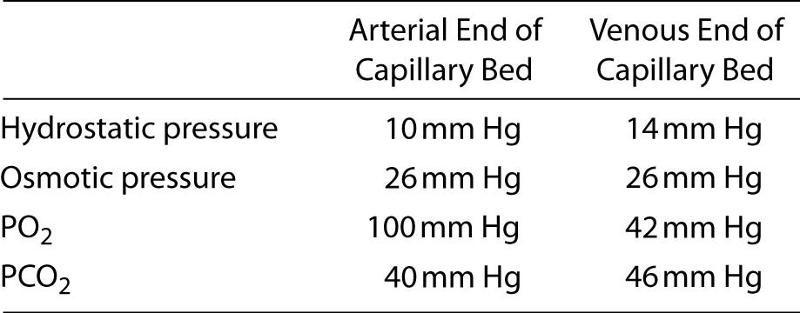
80) For this unusual capillary bed,
E) fluids will leave the capillaries on the arterial side of the bed and re-enter on the venous side.
81) An anthropologist discovers the fossilized heart of an extinct animal. The evidence indicates that the organism's heart was large, well-formed, and had four chambers, with no connection between the right and left sides. A reasonable conclusion supported by these observations is that the
B) animal was endothermic and had a high metabolic rate.

81) The results shown in the graphs support the hypothesis that
B) adding the drosomycin gene to such mutants protects them from fungal infection.
82) A group of students was designing an experiment to test the effect of smoking on grass frogs. They hypothesized that keeping the frogs in a smoke-filled environment for defined periods would result in the animals developing lung cancer. However, when they searched for previously published information to shore up their hypothesis, they discovered they were quite wrong in their original assessment. Even though they were never going to go ahead with their experiment (so as not to harm frogs needlessly), they knew that a more likely outcome of putting carcinogens in the air would be the development of
B) skin cancer.
83) Which of the following respiratory systems is not closely associated with a blood supply?
C) the tracheal system of an insect
84) Blood returning to the mammalian heart in a pulmonary vein drains first into the
B) left atrium.
85) Pulse is a direct measure of
D) heart rate.
86) When you hold your breath, which of the following blood gas changes first leads to the urge to breathe?
<p>C) rising CO₂</p> 87) One feature that amphibians and humans have in common is
87) One feature that amphibians and humans have in common is
D) the number of circuits for circulation.
88) If a molecule of CO₂ released into the blood in your left toe is exhaled from your nose, it must pass through all of the following except
A) the pulmonary vein.
89) Compared with the interstitial fluid that bathes active muscle cells, blood reaching these cells in arteries has a
A) higher PO₂.
9) As body size increases in animals,
<p>A) there is a decrease in the surface-to-volume ratio.</p> 9) In which of the following organisms does blood flow from the pulmocutaneous circulation to the heart before circulating through the rest of the body?
9) In which of the following organisms does blood flow from the pulmocutaneous circulation to the heart before circulating through the rest of the body?
D) frogs
9) Salmonella bacterial poisoning can be initiated when
A) the microbe survives the acidic environment of the stomach and resists lysosomal degradation in macrophages.
90) Which of the following reactions prevails in red blood cells traveling through alveolar capillaries? (Hb = hemoglobin)
A) Hb + 4 O₂ → Hb(O₂)₄
94) Which of these is not part of insect immunity?
B) activation of natural killer cells
95) An epitope associates with which part of an antigen receptor or antibody?
C) variable regions of a heavy chain and light chain combined
96) Which statement best describes the difference in responses of effector B cells (plasma cells) and cytotoxic T cells?
C) B cells secrete antibodies against a pathogen; cytotoxic T cells kill pathogen-infected host cells.
97) Which of the following statements is not true?
D) A lymphocyte has receptors for multiple different antigens.
98) Which of the following should be the same in identical twins?
<p>B) the set of MHC molecules produced</p> 99) Vaccination increases the number of
99) Vaccination increases the number of
B) lymphocytes with receptors that can bind to the pathogen.
The phenotype of the HA3 knockout can be ascertained by
D) the measurement of the proportion of CD4 cells to total lymphocytes.